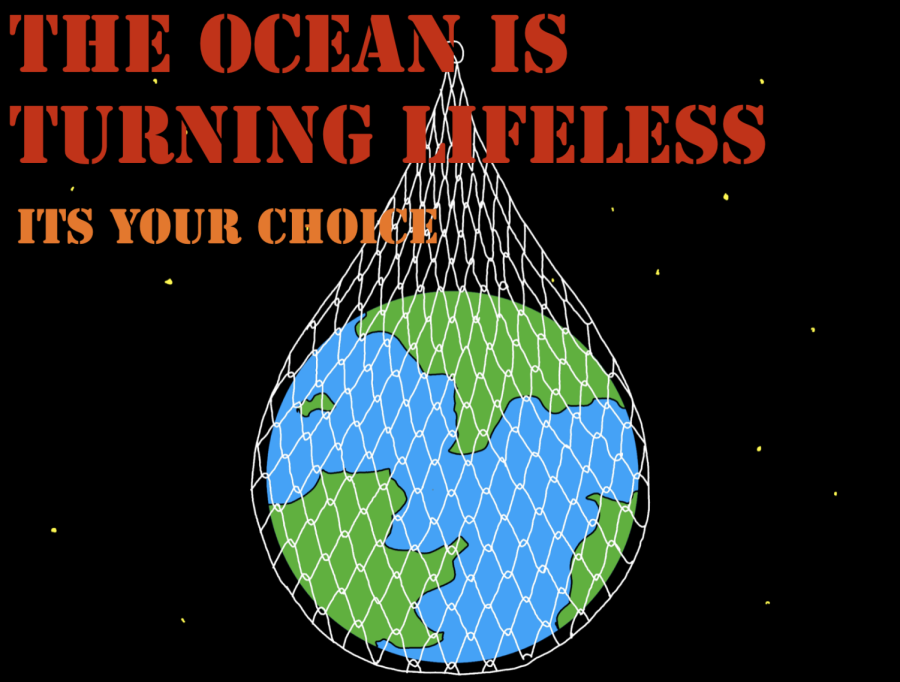Your choice: a lifeless ocean
Apr 29, 2022
The rolling surface of the ocean is disrupted by a fishing net crashing into the depths. Thousands of fish, dozens of sharks, and several marine mammals are indiscriminately pulled to the surface. Of the sea creatures that are suddenly pulled out of their world and thrown on the deck of a fishing ship, none will survive. The nets are then cut and thrown away into the ocean, where they will pollute the waters and kill even more creatures.
Overfishing is a global issue that is threatening the delicate stability of the world’s marine ecologies. Overfishing is especially problematic because as described earlier, net fishing captures both fish species sought by the fishermen and millions of bycatch, creatures that are not meant to be caught, every year. In fact, according to the World Wildlife Fund, an NGO focused on nature conservation, bycatch accounts for 40.4 percent of the global marine haul every year; this figure could be high because a large percentage of bycatch is simply thrown away and not reported.
Currently, 2,270 marine species are at risk of extinction, the largest reason being overfishing. The unchecked fishing not only decreases specific species’ numbers, but it disrupts the balance of the entire food web, causing unpredictable disturbances to other oceanic species. Overfishing also threatens the populations of keystone species or species that have a large influence on the preservation of an ecosystem, such as sharks.
Overfishing is not a new issue, and it has been documented as a problem as early as the 1800s when whale populations sharply declined due to demand for their oil. This begs the question: if overfishing was known as a problem for so long, why has nothing been done to fix it? The answer is the same as a lot of other global issues such as climate change and plastic pollution: human demand.
Even though the biomass of fish available for harvest is decreasing every year, the demand for fish has been increasing exponentially for several decades. In fact, while the current annual fish production is 179 million tons, that figure is slated to expand to 204 million tons by 2030. The demand for endangered species such as bluefin tuna is also increasing, which is detrimental as their population growth is much slower than their removal from the ocean.
All of this can be traced back to human demand for food, and especially in developed nations, the demand for exotic food. For example, caviar is a delicacy that can be found in many high-end restaurants and hotels. In the 1800s and 1900s, it was so abundant that it was served as snacks in barbershops. However, as it gained popularity and increased in value, the sturgeon population that produced caviar was hunted to near extinction. Their population still has not recovered What can you do to contribute to this multifaceted issue? Well, the answer does not necessarily entail cutting down fish consumption altogether or switching to fish alternatives; it is rather centered on choosing more sustainable species of fish.
For example, have you ever wondered why tuna sushi at a restaurant costs up to 10 times more than a can of tuna? That is because they are not the same species. Expensive sushi tuna are usually species whose populations are decreasing in the wild, such as bluefin tuna, while canned tuna is the more sustainable species of albacore tuna.
This isn’t to say that eating canned tuna is the solution, because quality and taste also plays a factor in the choice of food. If you are wondering if your favorite fish to eat is considered sustainable, you can search the website of the Marine Stewardship Council (MSC), a non-profit that sets. standards for sustainable seafood. As of 2020, over 18,000 fish were deemed sustainable by the MSC, so your options are not as limited as you might think.
If what you are eating is unsustainable or even endangered, try finding different alternatives. Since there are so many options of fish that are sustainably harvested every year, there will likely be many alternatives similar in quality and taste.
29Because this is such a large issue, you may think that your choices might not have a great impact. However, if you can tell yourself and five people around you to make the change and choose sustainable fish, your choices will add up. Even though the process will be slow and demand might seem infallible, as more and more people realize the dangers of overfishing and the demand for exotic seafood, your choice could prevent a lifeless ocean.







